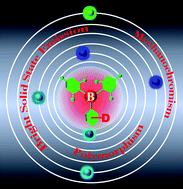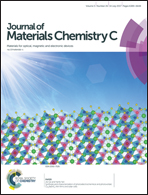H-Bond assisted mechanoluminescence of borylated aryl amines: tunable emission and polymorphism†
Abstract
Design, synthesis and structural characterization of borylated aryl amines, Mes2BAr {Ar = C6(CH3)4NR2 (1, 4); C6H4NR2 (2, 5); C6H3(NR2)2 (3, 6); R = H or CH3}, were reported. The intriguing optical signatures undoubtedly revealed their donor–acceptor characteristics and a bright tunable solid state emission is readily realized. The solid state luminescence characteristics of 1 and 3 were sensitive to mechanical stress with distinguishable emission color changes. Multiple strong intermolecular hydrogen bonds (N–H⋯N and N–H⋯π) accompanied by subtle conformational changes play a significant role in the piezochromic response. PXRD and FT-IR spectroscopic studies and insensitivity of substituted derivatives to mechanical stress support the above inference. Interestingly, compound 3 crystallized in two different polymorphic forms 3BP and 3GP, which showed distinct luminescence, i.e., green and blue color under UV light. Such changes are due to their distinct hydrogen-bond network assembly in the solid state. Quantum mechanical calculations were performed in order to corroborate the optical properties.



 Please wait while we load your content...
Please wait while we load your content...